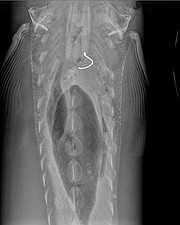Study: Metal ingested by sturgeon doesn't affect fish's population
Eric Barker Lewiston Tribune | Hagadone News Network | UPDATED 7 years, 1 month AGO
A study of sturgeon in Hells Canyon determined a significant portion of the long-lived fish have hooks and other fishing tackle in their digestive tracts, but they seem to be able to process and pass the metal without harm.
Fisheries biologists with the Idaho Department of Fish and Game and the Idaho Power Company scanned more than 2,000 sturgeon with metal detectors and used a portable X-ray machine on about 450 of them to document the prevalence of fishing tackle in the bellies of the fish.
They found about 21 percent of the sturgeon they examined had tackle in their bellies. Many of the sturgeon were captured multiple times during the four-year project. Recaptured fish with fishing tackle in their systems passed the metal in about 492 days on average. Recaptured fish ingested new metal about every 575 days on average.
The study, published by the American Fisheries Society, showed that fish with metal in the digestive tracts weighed slightly less than sturgeon of the same size without metal. However, the differences in weights were slight, suggesting the metal may affect their ability to feed or process food but not to a degree that would harm them on a population level.
The study also determined that most of the hooks and other fishing gear found in sturgeon were likely the result of the fish feeding on baited hooks that remained in the river after they had been snagged on rocks and broken off rather than from sturgeon deeply swallowing baited hooks still attached to fishing rods.
Joe DuPont, regional fisheries manager for the Idaho Department of Fish and Game at Lewiston and an author of the study, said the results show there isn’t a need to require anglers to use gear less prone to deep hooking and that metal ingested by sturgeon is not likely to limit the population of the popular game fish. Idaho and Oregon have long required anglers fishing in the Snake River to release sturgeon.
“We found fish with hooks in them versus not are pretty much in the same condition as far as length and weight,” DuPont said. “We also found they are cycling the hooks through them.”
The metal eventually breaks down from oxidation.
DuPont said one sturgeon sampled during the study had 14 pieces of fishing gear in it. He said that fish, caught in the fall, appeared skinny and he wondered if it would survive the winter. However, the fish was recaptured in the spring and had passed most of the metal and returned to a normal weight.
“Even in dire situations like that, they can live through it and recover fairly rapidly,” he said.
At one point in time, fisheries managers were trying to get sturgeon anglers to voluntarily change to circle hooks that are less prone to being swallowed deeply by fish. DuPont said based on the study, a rule change requiring circle hooks is not needed.
Several years ago, the department also implemented a rule that required sturgeon anglers to use sliding weights that are attached to the main fishing line with lighter-test line. Using a slider to attach the weight allows it to drop off if the main line should break for any reason. If the weight becomes snagged on the bottom, sliders allow anglers to break the lighter-test line and retrieve the hook. Under either scenario, it reduces the chance of leaving a baited hook anchored to the river bottom.
DuPont said the sliding weight rule will be maintained. It’s unclear if the rule makes a big difference in sturgeon survival, but it may do some good, he said, without hindering the ability of anglers to catch sturgeon.
The study found that most of the metal in sturgeon was related to sturgeon fishing instead of the smaller hooks used for bass or steelhead. DuPont said it’s likely the smaller hooks and gear associated with bass and steelhead fishing are easier for sturgeon to pass, although that finding wasn’t part of the study.
ARTICLES BY ERIC BARKER LEWISTON TRIBUNE

Anglers won't get lion's share of returning spring chinook
An early forecast from a group of state, tribal and federal fisheries managers indicates the upcoming spring chinook season could be as, or even more, disappointing than recent steelhead runs and worse than last year’s return of springers.

Fish scales break even in 2020
Adult returns of Snake River salmon and steelhead are the gold standard when measuring efforts to recover the imperiled fish. And by that standard, we don’t have much gold.

WDFW explores upland acquistion in the Asotin, Grande Ronde areas
The Washington Department of Fish and Wildlife wants public comments associated with its exploration of acquiring more property in Asotin and Garfield counties.



